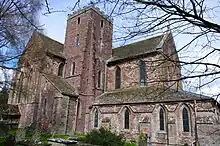Scheduled monuments in Herefordshire
There are 273 scheduled monuments in the county of Herefordshire, England.[1] These protected sites date from the Neolithic period and include barrows, churchyard crosses, ruined abbeys, castles, and Iron Age hill forts.[2] In the United Kingdom, the scheduling of monuments was first initiated to insure the preservation of "nationally important" archaeological sites or historic buildings. The protection given to scheduled monuments is given under the Ancient Monuments and Archaeological Areas Act 1979[3]
Notable scheduled monuments in Herefordshire
| Image | Name | Location | Date | Notes |
|---|---|---|---|---|
 |
Aconbury Camp | 51°59′37″N 2°43′28″W | Iron Age | Large univallate hillfort located on Aconbury Hill.[4] |
 |
Arthur's Stone chambered tomb | 52°04′56.3″N 02°59′43.3″W | Neolithic era | This burial monument is linked with the legend of King Arthur.[5] |
 |
Brampton Bryan Castle | 52.3478°N 2.9263°W | late 13th century-14th century AD | 14th century castle ruins.[6] |
.jpg.webp) |
Dinedor Camp | 52.0235°N 2.6963°W | Iron Age | Iron Age Hillfort. |
 |
Dore Abbey | 51.96778°N 2.89368°W | 1147 AD | Cistercian abbey ruins.[7] |
See also
References
- "Scheduled monuments in Herefordshire". Historic England. Retrieved 9 May 2023.
- "Scheduled Ancient Monuments in the Historic County of Dorset". Ancient Monuments UK. Retrieved 28 January 2023.
- "Scheduled Monuments". Historic England. Retrieved 4 May 2023.
- "Aconbury Camp". Historic England. Retrieved 11 May 2023.
- "Arthur's Stone Neolithic burial chamber, 450m south west of Mount Pleasant". Historic England. Retrieved 10 May 2023.
- "Brampton Bryan Castle". Historic England. Retrieved 10 May 2023.
- "Dore Abbey: a Cistercian monastery". Historic England. Retrieved 10 May 2023.
This article is issued from Wikipedia. The text is licensed under Creative Commons - Attribution - Sharealike. Additional terms may apply for the media files.